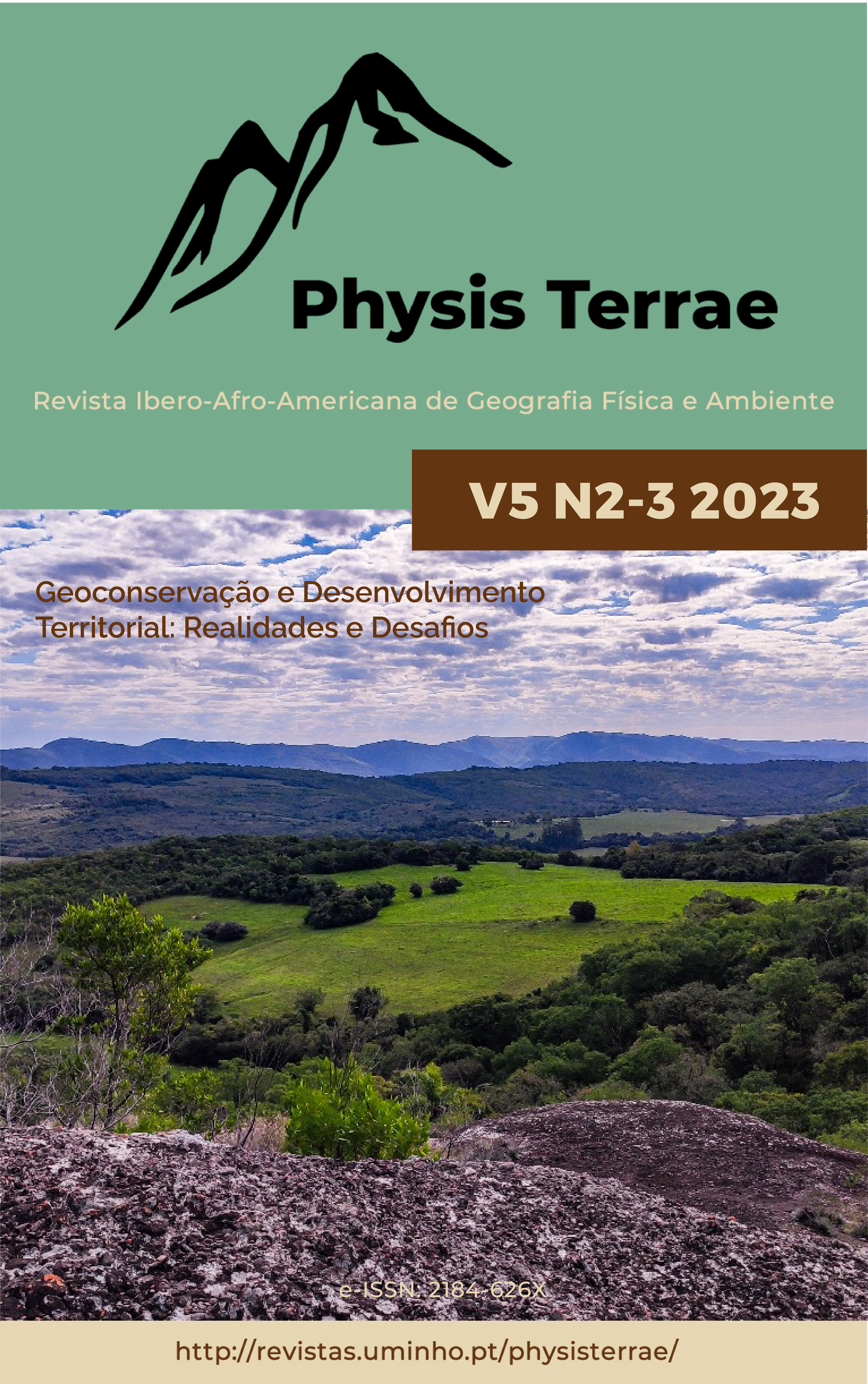Geoeducational itinerary in geossites of different categories in Geopark Araripe, Ceará
DOI:
https://doi.org/10.21814/physisterrae.5566Keywords:
Geodiversity, Geoeducation, Geoeducational itinerary, Classroom in the fieldAbstract
The geoeducational itineraries and classes in the field are important educational strategies for the perception and appreciation of geodiversity by civil society and, mainly, Basic Education students. Given the above, the objective of this work is to propose geoeducational routes through field classes according to the different geosite typologies of the Araripe Geopark, Ceará. From a methodological point of view, the geosites were classified according to the main interest of geodiversity. As a result, three geoeducational routes were proposed: a paleontological route, in the Petrified Forest, Pterosauros Park and Cariri Stone geosites; geomorphological route, Colina do Horto, Pontal de Santa Cruz and Ponte de Pedra, and; hydrogeological route, in the Batateira, Riacho do Meio and Cachoeira de Missão Velha geosites. For each geosite category according to the main interest of geodiversity, the objectives, best period for visitation, logistics and infrastructure were considered in the planning of the geoeducational routes, as well as the vulnerabilities/limitations for carrying out the activity through field classes with children and teenagers, thus allowing, the valuation of the Geopark Araripe's geoheritage and the redefinition of this teaching methodology in the context of School Geography.
Downloads
References
Albuquerque, F. N. B. (2019). Geodiversidade e ensino de Geografia: um ensaio metodológico. Revista Equador, 8(2), 170 – 185. https://doi.org/10.26694/equador.v8i2.9222
Brilha, J. B. R. (2009). A Importância dos geoparques no ensino e divulgação das Geociências. Revista do Instituto de Geociências – USP, 5, 27-33. https://doi.org/10.11606/issn.2316-9087.v5i0p27-33
Corrêa Filho, J. J. (2015). Aula de campo: como planejar, conduzir e avaliar? (1. ed). Petrópolis, RJ: Vozes.
Figueiró, A., Motta, V., Brunhauser, T., Ventura, H., & Cechin, D. (2019). A produção de materiais geoeducativos na proposta do Geoparque Quarta Colônia, RS. Physis Terrae - Revista Ibero-Afro-Americana de Geografia Física e Ambiente, 1(2), 171-184. https://doi.org/10.21814/physisterrae.2274
Fornaro, A., & Fernandes, A. M. (2018). Geoparks: from conception to the teaching of Geosciences. Terræ Didatica, 14(3), 330-338. https://doi.org/10.20396/td.v14i3.8653533
Fuertes-Gutiérrez, I., & Fernández-Martínez, E. (2010). Geosites inventory in the Leon Province (Northwestern Spain): a tool to introduce geoheritage into regional environmental management. Geoheritage, 2(1-2), 57–75. https://doi.org/10.1007/s12371-010-0012-y
Gray, M. (2013). Geodiversity: valuing and conserving abiotic nature (2 ed.). Chichester, England: John Wiley & Sons.
Henriques, M. H., Tomaz, C., & Sá, A. A. (2012). O Geoparque de Arouca (Portugal) como recurso educacional: um estudo de caso. Episódios, 35, 481-488.
Maciel, A. B. C. (2020). A geodiversidade do município de Natal-RN: proposta de geomorfossítios e roteiro geoeducativo. Tese de Doutorado em Geografia. Centro de Ciências Humanas, Letras e Artes, Universidade Federal do Rio Grande do Norte, Natal.
Nascimento, M. A. L., Ruchkys, U., & Mantesso-Neto, V. (2008). Geodiversidade, geoconservação e geoturismo: trinômio importante para a proteção do patrimônio geológico. São Paulo: SBGeo.
Oliveira, B. A., & Albuquerque, F. N. B. (2021). Geoconservação e educação ambiental no geoparque Araripe (Ceará) por meio de oficinas didáticas e aulas em campo. International Journal Semiarid, 4(4), 126 – 138. https://doi.org/10.56346/ijsa.v4i4.91
Oliveira, C. D. M., & Assis, R. J. S. (2009). Travessias da aula em campo na geografia escolar: a necessidade convertida para além da fábula. Educação e Pesquisa, 35(1), 195-209. https://doi.org/10.1590/S1517-97022009000100013
Oliveira, J. M. S., Falcão Sobrinho, J., & Albuquerque, F. N. B. (2022). Percepção da paisagem no ensino de Geografia: desenhando a paisagem “nossa de cada dia”. Geopauta, 6, 1-18. https://doi.org/10.22481/rg.v6.e2022.e10092
Vallerius, D. M., Santos, l. A., & Mota, H. G. S. (2020). Geodiversidade, geoconservação e geoturismo: possibilidades de ações geoeducativas no ensino de Geografia. Humanidades & Inovação, 7(13), 86-94. Disponível em: https://revista.unitins.br/index.php/humanidadeseinovacao/article/view/3429
Downloads
Published
How to Cite
Issue
Section
License
Copyright (c) 2023 Bruna Almeida de Oliveira, Francisco Nataniel Batista de Albuquerque

This work is licensed under a Creative Commons Attribution 4.0 International License.


